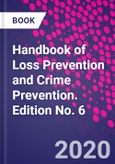Handbook of Loss Prevention and Crime Prevention, Sixth Edition, continues to serve as the preeminent, comprehensive resource for devising practical, modern solutions for securing people and property. The book presents the latest key applications for securing structures with Crime Prevention Through Environmental Design (CPTED), including plan review, report writing, presentation skills, lighting, zoning and behavioral management. Other sections address the latest issues related to active shooter situations, information technology, and international terrorism. Practical examples are provided, exploring applications for limiting retail crime and employing disaster readiness strategies.
Edited by seasoned, trusted security practitioner Lawrence Fennelly, the book features contributions by some of the most well-known experts in the field. Readers will find this book to be a trusted resource for physical security professionals, students and certification candidates who must navigate, and make sense of, today's most pressing domestic and international security issues.
Please Note: This is an On Demand product, delivery may take up to 11 working days after payment has been received.
Table of Contents
1. Encompassing CPTED in 2020 and Beyond2. Designing Crime Risk Management3. Designing Security and Working with Architects4. Introduction to Vulnerability Assessment5. The Security Survey and The Audit6. Vulnerability Assessment Process Inputs Establish Protection
Section A. Objectives7. Approaches to Physical Security and Deterrents8. Bringing CPTED into the 21st Century9. Environmental Criminology and Crime Control10. Problem Solving and Effective Community Policing11. Neighborhood Watch Guidelines for the Twenty-First Century12. Situational Crime Prevention and Opportunity Blocking
Section B. Planning and Evaluation13. Design and Evaluation of Physical Protection Systems14. Planning, Management and Evaluation15. Crime Analysis16. Standards, Regulations, and Guidelines: Compliance and Your Security Programs, Including Global Resources and Master Plan
Section C. Security Operations, Tools, and Technology17. Access Control, Access Badges and Biometrics Characteristics18. Intrusion Detection Systems19. Security Surveillance Systems20. Security Lighting
Section D. Technology21. Information Technology Systems Infrastructure
Section E. Delay22. Protective Barriers23. Physical Barriers24. Fences and Walls25. The Use of Locks in Physical Crime Prevention26. Safes and Vaults
Section F. Response27. Today's Security Officer and SRO28. Bomb Threats29. Internal Theft Controls30. Safe Schools and Safe Campuses31. Domestic Violence: Can It Be Stopped32. Proprietary Information33. Identity Theft34. Retail Security & Employee Theft35. High Rise Building Security36. Multi-Residential Security37. Lodging Hospitality Security38. Emergency Management39. Cargo Theft and Cargo Security40. Soft Targets
Authors
Lawrence J. Fennelly Expert witness and consultant in security, Litigation Consultants Inc., Massachusetts, USA.Lawrence J. Fennelly is an internationally recognized authority on crime prevention, security planning and analysis, and on the study of how environmental factors (CPTED), physical hardware, alarms, lighting, site design, management practices, litigation consultants, security policies and procedures, and guard management contribute to criminal victimization.
Mr. Fennelly was previously employed with Apollo Security, Computershare, Inc., as well as a sergeant at Harvard College, employed by the Harvard University Police Department in Cambridge, Massachusetts. He was trained as a crime prevention specialist and served in this capacity for over 21 years at Harvard. He was also the department's training officer and assistant court officer. As part of his role as an officer at Harvard, Larry also was a deputy sheriff in both Suffolk and Middlesex counties (Massachusetts). Mr. Fennelly is a frequent speaker and lecturer on CPTED, physical security, school crime, and other issues. He serves as an expert witness who works closely with attorneys in defense as well as plaintiff cases, assisting in case preparation, offering knowledgeable questions to ask the opposing side, etc. He has also done a considerable amount of consultant work throughout the United States. His experience ranges from identifying vulnerabilities to conducting security and lighting surveys, working with architects to design and implement security, and developing long range guard training programs and risk assessments of various facilities. He is also a prolific author. His titles include such well-known security books as "Crime Prevention Through Environmental Design," "Effective Physical Security," and "Handbook of Loss Prevention and Crime Prevention."








